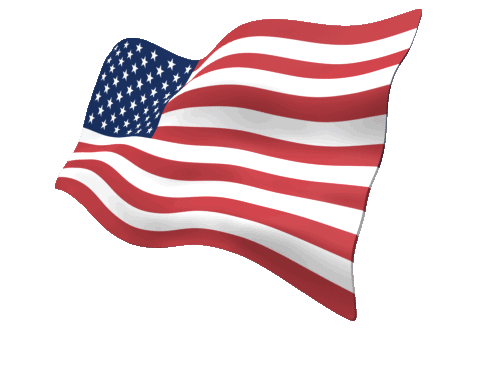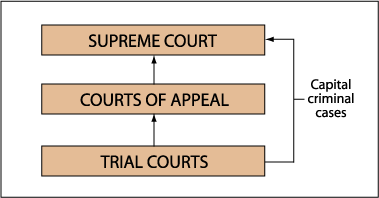
Mr. Dostert's Domain




The Judicial Branch
The Supreme Court
The Judicial Branch is the branch of government pressed with two duties; interpreting the law and resolving disputes within society. Within the United States there are two overlapping court systems, the federal court system as well as the state courts. Each system uphold the law while always abiding by the highest law in our country, the Constitution of the United States.

The Supreme Court (pictured above) is the highest court in the United States. Its decisions are final in all cases. Its most powerful tool is in its power of Judicial Review. Judicial Review allows the supreme court to judge whether a law or executive act follows the constitution. If the law or act is found to be in violation of the constituion is is nullified and made void. In this way the Judicial Branch oversees all other branches and can overrule both the Legislative and Executive branches.
Establishing Justice
The true purpose of every court is to establish justice for all its citizens. Our nation is built on the principle of the Rule of Law which declares that here is no person, institution, or official that is above the law. Because justice is a very subjective term, each case is handled separately and judged independently based on the circumstances and how they fall within the Law.
The court system establishes justice two ways: through criminal law, and civil law also called torts.

Criminal Law
Criminal Law is designed to punish those who break the law. It regulates conduct of society by ensuring that people are acting in a way that is best for society by regulating whatever is threatening, harmful, or otherwise endangering to the property, health, safety, and moral welfare of people. It then prescribes punishment for those who violate these laws. The defendent is guaranteed a trial by jury by the constitution in which there must be a unanimous decision in which guilt is established beyond a reasonable doubt.

Civil Law

Civil Law is designed to settle private disputes and create equity between persons or organizations. When a plaintiff files a suit against a defendent, a judge determines whether or not that claim deserves compensation based on the law. The judge then reaches a settlement which is determined to be equitable.


Jurisdiction
Jurisdiction is the authority of a court to hear a case. This issue is always important in any trial or court hearing. Jurisdiction has different forms and comes from different reasons, but before any case can be heard it must be determined that the court holds jurisdiction over the case in question. Generally speaking there are two factors that determine jurisdiction: location and subject matter.
State v. Federal Jurisdiction
The law in question is always at the heart of every case. Whether the violation was against a state law or federal law will determine whether the court case will be heard in a state court or a federal court. Believe it or not most laws are state laws and not federal laws. This is because of the 10th Amendment of the Constitution which reserves the powers not given to the federal government to the states. In essence this means that if the constitution did not discuss the issue then it is up to the states to decide for themselves. Therefore everything from armed robbery to murder is actually a state crime and not a federal issue. Federal crimes generally involve violations in the rights of individuals or interstate/international conflicts.

Within state and federal jurisdictions sometimes conflicts arise. When both the federal government and the state government hold jurisdiction over the same issue it is called concurrent jurisdiction. In these circumstances the federal government has the final say because it has a higher authority than the states on who will hear the case although it is often left to the states do reduce the workload of the federal courts.



In other circumstances the Federal Government holds exclusive juristiction. This means that the case can only be heard in a federal court. These court cases include things such as federal crimes, bankruptcy, patents, or suits against the United States government or a foreign firm or government.
Original v. Appellate Jurisdiction
Another two types of jurisdiction found in the court system is original jurisdiction and appellate jurisdiction. Original jurisdiction is held by the court which hears a case for the first time. Appellate jurisdiction is the ability of a court to rehear a case due to some abnormality during the trial or because there is another issue that the higher court wishes to review or redress.

Courts with appellate jurisdiction have three options when the hear a case: they can confirm or uphold the decision of the lower courts, they can overturn or reverse the decision of the lower courts, or they can remand the case to a lower court for retrial with new instructions and new evidence which must be considered.
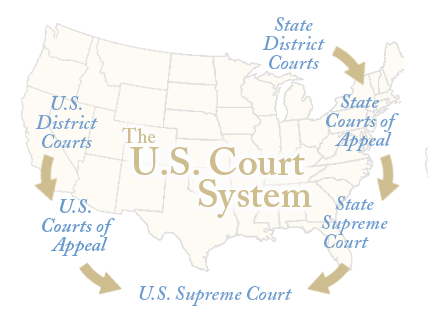

There is only one court which holds both original and appellate jurisdiction in the United States; the Supreme Court. Its decisions are final and can only be overturned by another Supreme Court decision.
The Supreme Court
The Supreme Court is the only court created by the Constitution of the United States within Article III. The Supreme Court has the highest authority in all legal proceedings. The members of the Supreme Court are known as Justices, with the highest ranking judge called the Chief Justice of the Supreme Court. The Justices are appointed by the President and confirmed by the Senate and once sworn in hold their position for life. There are currently 9 Supreme Court Justices serving in the Supreme Court.

-
John Roberts
-
Antonin Scalia
-
Anthony Kennedy
-
Clarence Thomas
-
Ruth Bader Ginsburg
-
Stephen Breyer
-
Samuel Alito
-
Sonia Sotomayor
-
Elena Kagan
When the Supreme Court decides to hear a case the court will listen to arguments and ask questions to attorneys presenting each side of a case. After discussion and deliberation the Court will release 3 types of decisions:
Majority Opinion- The Majority opinion is the official decision of the Court which is agreed to by more than half of the court. The Majority Opinion will give the official decision the court has made as well as explain the rationale for their decision. By writing their rationale the court sets what is known as precedent, meaning that all future cases with similar circumstances will be ruled upon based on this decision.
Concurring Opinion- A Concurring Opinion is the opinion of one or more justices which agree with the decision of the majority opinion but for a different reason or rationale.
Dissenting Opinion- A Dissenting Opinion is the opinion of the minority who disagree with the official ruling of the court. A dissenting opinion holds no official authority, but is written in hopes that in the future the Majority Opinion can be overturned.

Criminal Trials
The right to trial by jury is guaranteed by the Seventh Amendment of the Constitution. Once an individual has been indicted by a grand jury the formal trial takes place. The accused becomes known as the defendant. The State (either the United States or the State which holds jurisdiction) then assumes the role of the prosecution. Other key players in the trial include the judge, who rules on procedure and legal issues that may arrise throughout a trial, and the jury who usually is made up of twelve members who have no connection to the defendant and is selected by the prosecution and the defense collectively.
The trial begins with opening statements by both the prosecution and the defense which will outline their basic strategies to the jury and the judge. The prosecuting attorney attempts to establish the guilt of the accused by displaying evidence and witness testimony over the course of their trial. The defense is allowed to cross-examine every witness presented by the prosecution as an attempt to show flaws in the prosecution's evidence. Once the prosecution rests the defense is given their turn to present their case and prove their client's innocence in a similar process to that of the prosecution through the presentation of evidence and the testimony of witnesses. Once the defense rests closing arguments are made and the jury leaves to deliberate.

When a jury meets to discuss the case following the trial their decision must be unanimous, otherwise there is what is known as a hung jury and a mistrial will be declared and a new trial will have to presented to a new jury. Another important note is that in the United States the burden of proof lies on the prosecution meaning that all defendents are presumed innocent unless proven beyond the shadow of a doubt to be guilty.
Once a decision has been made the jury returns to read the verdict:
If the defendent is found innocent he/she is released from custody to resume their lives. Once found innocent the defendent can never again be tried for the same crime which is known as double jeopardy.
If the defendent is found guilty the judge then decides the sentence or punishment for the crime. Once sentenced the defendent can appeal the decision of the court if there has been an irregularity or if new evidence is discovered.
Important Cases
Although the Supreme Court cannot manufacture law, the way it interprets the Constitution can influence how it is upheld by the United States. There have been many examples of cases which have reshaped the understanding of freedom, rights, and liberty in the United States, here are a few that we will be looking at:

-
Marbury v. Madison (1803)
-
McCulloch v. Maryland (1819)
-
Dred Scott v. Sanford (1857)
-
Plessy v. Ferguson (1896)
-
Miranda v. Arizona (1966)
-
Roe v. Wade (1973)

It is important to remember that the Supreme Court is reactionary, meaning that it cannot take action unless an case is brought forth to it. These decisions have largely altered the way that American Democracy is administered and over time changed our understanding of freedom, equality, and liberty. As you can see from several of the cases above, that understanding often changes over time and the beliefs and opinions of the court today may not be the beliefs of the future. As people change, so too does the Supreme court and their understanding of the Constitution of the United States
Legal Considerations
Democracy cannot exist without civil liberty- that is, without individual freedom. But democracy also requires some degree of authority to protect individuals and that freedom. This delicate balance between freedom and authority is one of democracy's greatest challenges, and one which is constantly in flux as society and its government struggle with the challenges of history and the balance is reassessed over and over again. The courts of the United States are at the forefront of this struggle as each case can create lasting effects which define how Americans and their government interact and how the word freedom will be defined, generation at a time.

The Unalienable Rights
The Constitution guarantees both rights and liberties to the American people. The distinction between civil rights and civil liberties is at best murky. Legal scholars often disagree on the matter, an the two terms are quite often used interchangeably.


In general, civil liberties are protections against government. They are guarantees of the safety of persons, opinions, and property from arbitrary acts of government. Examples of civil liberties include freedom of religion, freedom of speech and press, and the guarantee of a fair trial.
The term civil rights is sometimes reserved for those positive acts of government that seek to make constitutional guarantees a reality for ALL people. From this perspective, examples of civil rights include a prohibition on discrimination on the basis of race, sex, religious belief, or national origin, set out in the Civil Rights Act of 1964.
The Constitution guarantees many different rights to everyone in the United States. Still, no one has the right to do anything he or she pleases. Rather, all persons have the right to do as they please as long as they do not infringe on the rights of others. Thus, all rights are relative and not absolute. To illustrate the point: Everyone in the United States has a right to free speech, but no one enjoys absolute freedom of speech. A person can be punished for using obscene language, or for using words in a way that causes another person to commit a crime- for example, to riot or to desert the military.



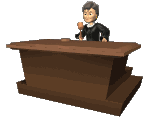

Twelve Angry Men
The film Twelve Angry Men (1957) is an American classic film which portrays twelve jurors struggling with a court case which seems on its surface to be simple. However as Juror #8, portrayed by Henry Fonda examines the evidence deeper, the jurors discover that the the evidence is not as full proof as initially believed. This film dramatizes the effects of bias, bigotry, and assumption on individuals lives, revealing just how important a fair and impartial jury truly is in democracy.
Supplementary Materials
Judicial Powers and Limitations
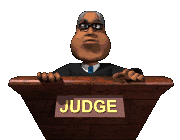
Resources
Crash Course: Supreme Court Procedures
The Supreme Court
Surprisingly, despite its role as a coequal branch of government, the Supreme Court was not provided with a building of its own until 1935, the 146th year of its existence.
Initially, the Court met in the Merchants Exchange Building in New York City. When the National Capital moved to Philadelphia in 1790, the Court moved with it, establishing Chambers first in the State House (Independence Hall) and later in the City Hall.
When the Federal Government moved, in 1800, to the permanent Capital, Washington, the District of Columbia, the Court again moved with it. Since no provision had been made for a Supreme Court Building, Congress lent the Court space in the new Capitol Building. The Court was to change its meeting place a half dozen times within the Capitol. Additionally, the Court convened for a short period in a private house after the British set fire to the Capitol during the War of 1812. Following this episode, the Court returned to the Capitol and met from 1819 to 1860 in a chamber now restored as the "Old Supreme Court Chamber." Then from 1860 until 1935, the Court sat in what is now known as the "Old Senate Chamber."
Finally in 1929, Chief Justice William Howard Taft, who had been President of the United States from 1909 to 1913, persuaded Congress to end this arrangement and authorize the construction of a permanent home for the Court. Architect Cass Gilbert was charged by Chief Justice Taft to design "a building of dignity and importance suitable for its use as the permanent home of the Supreme Court of the United States."
Neither Taft nor Gilbert survived to see the Supreme Court Building completed. Construction proceeded under the direction of Chief Justice Hughes and architects Cass Gilbert, Jr., and John R. Rockart. The construction, begun in 1932, was completed in 1935, when the Court was finally able to occupy its own building.
The classical Corinthian architectural style was selected because it best harmonized with nearby congressional buildings. The building was designed on a scale in keeping with the importance and dignity of the Court and the Judiciary as a coequal, independent branch of the United States Government, and as a symbol of "the national ideal of justice in the highest sphere of activity."


